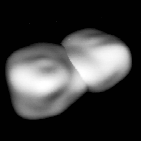
Asteroid 4769 Castalia is a near-Earth crossing asteroid that was discovered by Eleanor F. Helin (Caltech) on August 9, 1989. Scientists used radio astronomy and computer modeling to generate this image of Castalia. They obtained the data for the computer model in 1989 using the Arecibo radar/radio telescope in Puerto Rico when the asteroid passed within 5.6 million kilometers (3.5 million miles) of the Earth. R. Scott Hudson (Washington State University) and Steven J. Ostro (JPL) used the detailed time-delay and Doppler data from the radio echos to produce this 3D computer model.
Castalia has a dumbell shape and is about 1.8 kilometers (1.1 miles) across at its widest. Its two distinct lobes are about .75 kilometers (.47 miles) across. It has a narrow waist of approximately 100 to 150 meters (330 to 490 feet) in depth. The two lobes were probably separate objects that came together after a relatively gentle collision. The surface of both lobes have similar composition and roughness. The effective resolution of the reconstruction is about 100 meters (330 feet). This is the first detailed 3D model of a near Earth asteroid yet produced, and the most conclusive evidence to date of a "contact-binary" object in the solar system.
The flyby, at 12:46 am EDT on July 29, occurred at an estimated distance of 16 miles (26 kilometers), although the exact distance is still being measured.
Back To Asteroid Menu
Use the "BACK" button on your Browser to return to the previous page.